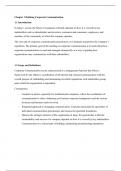Chapter 1 Defining Corporate Communication
1.1 Introduction
In today’s society the future of companies critically depends on how it is viewed by key
stakeholders such as shareholders and investors, customers and consumers, employees, and
members of the community in which the company operates.
The core task of corporate communication practitioners is to maintain and protect the company’s
reputation. The primary goal of the teaching on corporate communication is to teach about how
corporate communication is used and managed strategically as a way of guiding how
organizations may communicate with their stakeholders.
1.2 Scope and Definitions
Corporate Communication can be characterized as a management function that offers a
framework for the effective coordination of all internal and external communication with the
overall purpose of establishing and maintaining favorable reputations with stakeholder groups
upon which the organization is dependent.
Consequence:
- Complex in nature, especially for multinational companies, where the coordination of
communication is often a balancing act between corporate headquarters and the various
divisions and business units involved.
- Integrated approach to managing communication, Corpcom transcends the specialties of
individual communication practitioners and crosses the specialist boundaries.
- Harness the strategic interests of the organization at large, the general idea is that the
sustainability and success of a company depends on how it is viewed by key stakeholders.
Communication is a critical part of building, maintaining and protecting reputations.
,Key concepts of corporate communication
Concept Defenition
Mission Overriding purpose in line with the values
and expectations of stakeholders
Vision Desired future state: the aspiration of the
organization
Corporate objectives Statement of overall aims in line with the
overall purpose
Strategy The ways or means in which the corporate
objectives are to be achieved and put into
effect
Corporate identity The profile and values communicated by
an organization
Corporate image The immediate set of associations of an
individual in response to one or more
signals or messages from or about a
particular organization at a single point in
time, 1 point at a time
Corporate reputation An individual’s collective representation of
past images of an organization established
over time
Stakeholder Any group or individual who can affect or
is affected by the achievement of the
, organization’s objectives
Communication The tactics and media that are used to
communicate with internal and external
groups
Integration The act of coordinating all communication
so that the corporate identity is effectively
and consistently communicated to internal
and external groups
The essence of the table is customers and prospects will purchase products and services, members
of the community will appreciate the organization in its environment, investors will grant
financial resources, and so on, because of favorable images and reputations.
Case example 1.1 Verizon: how (not) to communicate with stakeholders
- In 2017, Verizon, one of Americas largest internet providers, began throttling (slowing
down) internet speeds for video streaming in a revamp (vernieuwen) of its unlimited data
payment plans. So people would upgrade to a more expensively priced scheme, where
bandwidth is not throttled.
- In 2018, Verizon’s throttling started affecting communication for essential public and
emergency services.
- After news on Verizon’s unresponsiveness, the company stopped it’s throttling tactics and
the corpcom department released a statement claiming that this was primarily a customer
service issue.
- This statement then raised questions in the public why the firefighters’ reasonable
demands were not met in line with its corporate policy
- In an attempt to address the negative impact of these events on the company’s reputation,
the communication and marketing teams of Verizon released an advert expressing the
, company’s dedication to supporting first responders and emergency aid. Which was then
poorly received due to the mistreatment of the firefighters and resulting court case.
- This case highlights the major issue in Verizon’s corporate communication, with the
company being taken off guard and its reputation being damaged because of its words and
actions not being consistent with one another.
Business communication, focusses almost exclusively on skills, and looks towards the individual
manager of professional, whilst corporate communication focuses on the entire company and the
entire function of management.
1.3 trends in Corporate Communication
In the 80s many corporations restructured separate communication disciplines such as media
relations, advertising, sales promotions, and product publicity, and brought these together into
more integrated departments or into specific working places. This enabled organizations to
provide strategic direction to all their communication with different stakeholder groups and to
derive guidance for communication efforts from the strategic interests of the organization as a
whole.
Since the early 90s and up until the 00s organizations became primarily concerned with ideas as
’corporate identity’, ‘corporate reputation’, and ‘corporate branding’, which emphasize the
importance of positioning. A favorable repetitional position in the minds of stakeholders drives
whether stakeholders want to transact with an organization and effectively choose the
organization over other, rival forms.
- The downside of this view is that it reinforced an assumption that corporate
communicators can strategically plan and design their messaging in order to, in effect,
‘take up’ a repetitional ‘position’ in the minds of stakeholders.
- Stakeholders as passive agent who respond to the communicators message
- This suggests a linear model of communication, as opposed to seeing communication as a
joint activity
New media technologies are the enabling factor in the process of communication, whilst the
mechanics might have changed, the overriding principle is, to some extent, still the same - that is,





